To commemorate the life of Pal Benko, July 15, 1928 – August 25, 2019, we present an article from Inside Chess August 10, 1988 Volume 1, Issue 16.
GM BENKO ON ENDGAME COMPOSITION
GM Pal Benko reveals the arcane world of the endgame composer.
Composing an Artistic Endgame
by GM Pal Benko
Most tournament players, especially those from the US, look upon chess problemists as E.T.-like aliens. However, these same players are often interested in artistic endgames as are chess problemists. For both the endgame problemist and the practical player share the desire to unearth hidden possibilities, surprising ideas, and game-like positions.
Unfortunately, practical players are often unacquainted with the art of the endgame composer. How, for example, does the composer go about making endgame problems? I’ve been asked this question many times by players of various strength. The GM editor of this magazine is one of those players. His request: demonstrate to the readers of Inside Chess how to make endgame problems “come alive.” I readily accepted, not only because I’ve had much experience playing endgames against some of the world’s best, but also because I’ve already written some articles on the subject in E.G., an English endgame magazine.

So let’s get to our task. As the endgame columnist for Chess Life, I get lots of submissions from problemists. Of course not all of these submissions are up to publication standards. The following problem is such a submission.
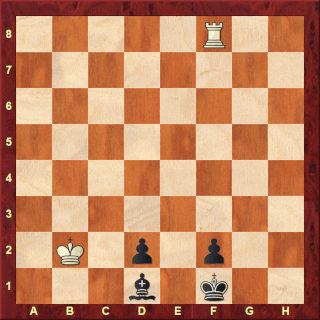
Solution: l.Kc3 Bf3 2.Kxd2 Kg2 3.Rg8+ Kh3 4.Rb8+ Kg4 5.Rg8+ Kh5 6.Rb8+ Kg6 7.Rh1 Bxh1 8.Ke2 drawing.
However, the route to the draw is faulty. There is a cook by 1…Ke1 2.Rxf2 Be2 winning.
If this example fails to carry through with its anticipation theme, the next one succeeds brilliantly.
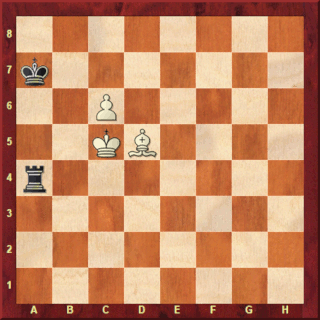 L. Ehrlich, 1929
L. Ehrlich, 1929
Solution: 1.c7 Ra5+ (if 2.Kb4? then Rb5+ =; or 2.Kd4 Kb6; or 2.Kc6 Rxd5 3.c8=Q Rc5 leads to stalemate) 2.Kc4 Ra1 3.Bc6 Rc1 4.Kd5 Rd1 5.Ke6.
At this point, White can try the important 5.Ke4!? Re1+ 6.Kd3 Re8+, drawing. This try demonstrates a successful version of the zig-zag Rook maneuver attempted in our first example. However, the idea was first used in a composition by J. Kling in the 19th century. Fortunately, Ehrlich incorporated a new theme into this stem idea:
5…Re1+ 6.Kf7 Rf1+ 7.Kg7 Rg1+ 8.Kh7, which finally wins as the a1-square is controlled by the Bishop.
Even though the composer of this problem elaborated nicely upon the original theme, I sought to enrich it even further. In discussing my work here, I hope to shed some light on how composition ideas are born. What follows are the results of my investigations.
Here’s my first attempt.
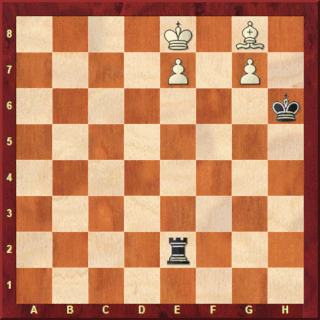 White wins
White wins
P. Benko
Note the resemblance between our first diagram and this one. The minor differences are that colors are reversed and the whole position is “distanced” somewhat. The major difference is that White wins. But how? The line that led to a demolition in the first composition merely leads the problemist into temptation here. Thus I.Kf8? Rxe7 2.Bf7 Re4 3.g8=Q Re8+! is stalemate. (Though White may underpromote to a Rook, a draw would still result.)
The solution is 1.Be6 Kxg7 2.Kd7 Rd2+ 3.Kc7 (drawing is 3.Kb6, etc. – the zig-zag theme – as well as 3.Kc8? Rf2 and Rf8) 3…Rc2+ 4.Kb7 Rb2+ 5.Ka7 winning, as Black has no more checks.
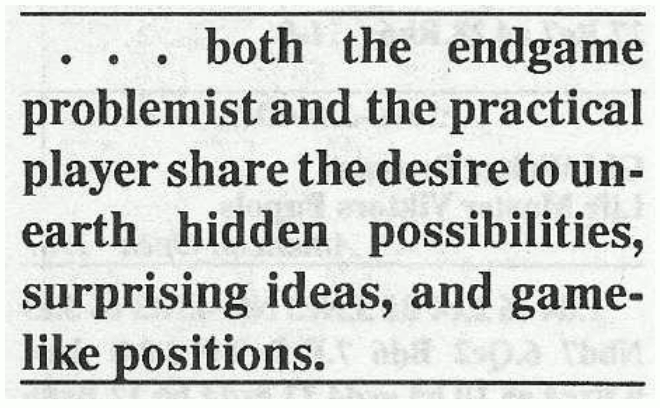
However, despite this addition, I could not say that this composition was an improvement on Ehrlich. Still unsatisfied, I searched for a new idea. I thought of replacing the g7-pawn with one on h2. White’s task in this case would be more difficult since his Bishop is the wrong color to win a B + h-pawn ending; White would have to use the h-pawn here since all the pieces in a problem must be necessary to realize the theme.
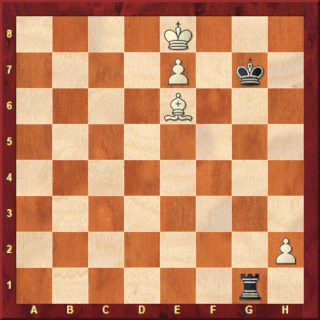 P. Benko
P. Benko
The solution: 1.Kd7 Rd1+ 2.Kc6 Rc1+ 3.Kd5. In our previous example, White could not avoid perpetual check from the Rook. But such is not the case here. 3…Rd1+ 4.Ke5 Re1+ 5.Kf5 Rf1+ 6.Kg5 Rg1+ 7.Kh5 and wins. Consider the difference if we use a “twin” by replacing Black’s Rook on g1 with one on g2.
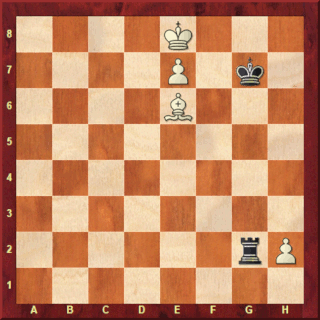 Use of a “twin.”
Use of a “twin.”
In this case, the white King cannot hide behind the h-pawn because the Rook captures with check, negating the zig-zag theme. But White has another possibility.
Solution: 1.Kd7 Rd2+ 2.Ke7 Rc2+ 3.Kb7 Rb2+ and 4.Ka7 wins.
This ending illustrates two ways to march the white King. However, I was still not satisfied, for there is no stalemate theme if White plays incorrectly. So I continued working with the h-pawn and the bad Bishop. Here’s the outcome:
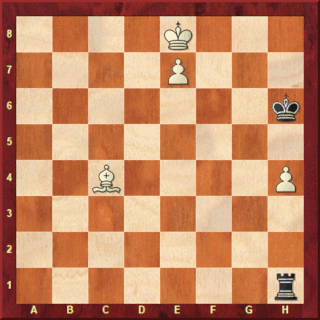 White wins
White wins
P. Benko
1st Prize, Magyar Sakkelet, 1981
The material is exactly the same, but the solver must avoid a devilish trap right from the beginning. At first glance, White appears to win easily with 1.Kf7 Re1 2.Be6 Rf1+ 3.Kg8 Rg1+ 4.Kh8. But Black is not finished yet. It’s stalemate after 4…Rg7 5.e8=Q Rh7+ 6.Kg8 Rh8+!.
So, the solver must look at 5.e8=R!? So tricky is this try that The Encyclopedia of Chess Endings gives 5…Rb7, with the plan …Rb4 and …Kh5, as equal. But 5…Rb7? loses after 6.Bc4 Rb4 7.Re6+ Kh5 8.Re4 Kh6 9.Kg8, etc. However, the draw is still there after the only good Rook move, 5…Rf7, since 6.Bg4? Rh7+ 7.Kg8 Rg7+ =. Naturally, 6.Bxf7 stalemates.
The correct method turns out to be 1.Be6, with the threat of a white King march by K-d7-c6-d5 and a zig-zag maneuver. Black has two tries:
(1) 1…Rd1. In this line, Black tries to prevent the white King from emerging. 2.h5. This preparatory move avoids the hidden stalemate possibility. If 2.Kf7?, then 2…Rf1+ draws, as we have seen. 2…Kg7 3.h6+ Kh7 4.Bf5+ Kg8 5.h7+ Kg7 6.h8=Q+ Kxh8 7.Kf7 Re1 8.Be6 Rf1+ 9.Kg6 with another zig-zag maneuver down the board.
(2) 1…Kg7 2.Kd7 Rd1+ 3.Kc6 Re1+ 4.Kd5 Rd1+ 5.Ke5!
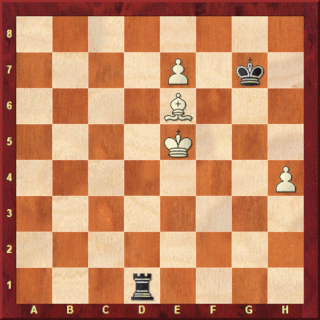
(5.Kc4? zig-zag =) 5…Re1+ 6.Kf5 Rf1+ 7.Kg5 Rg1+. There is no salvation in 7…Rf8 8.exf8=Q+ Kxf8 9.Kf6. And now 8.Kh5! wins. Interesting, the King hides behind the pawn, which in the other line had to be sacrificed.
What lesson can we draw from these investigations? I would say that a composer should not be satisfied too soon with his work. He must try to extract the maximum from his theme and material. At the same time, it seems to me that even old favorites may offer scope for new ideas.
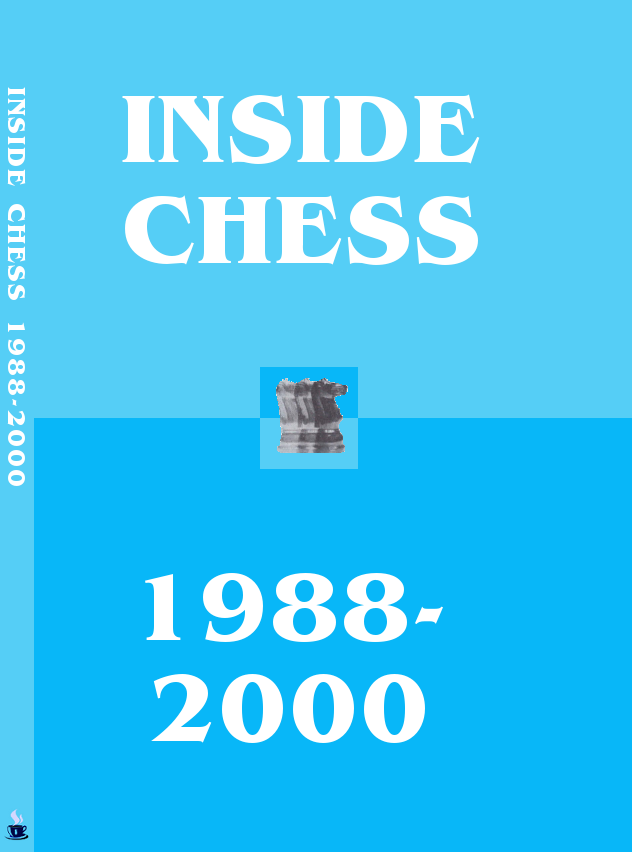

Leave a Reply